Your cart is currently empty!
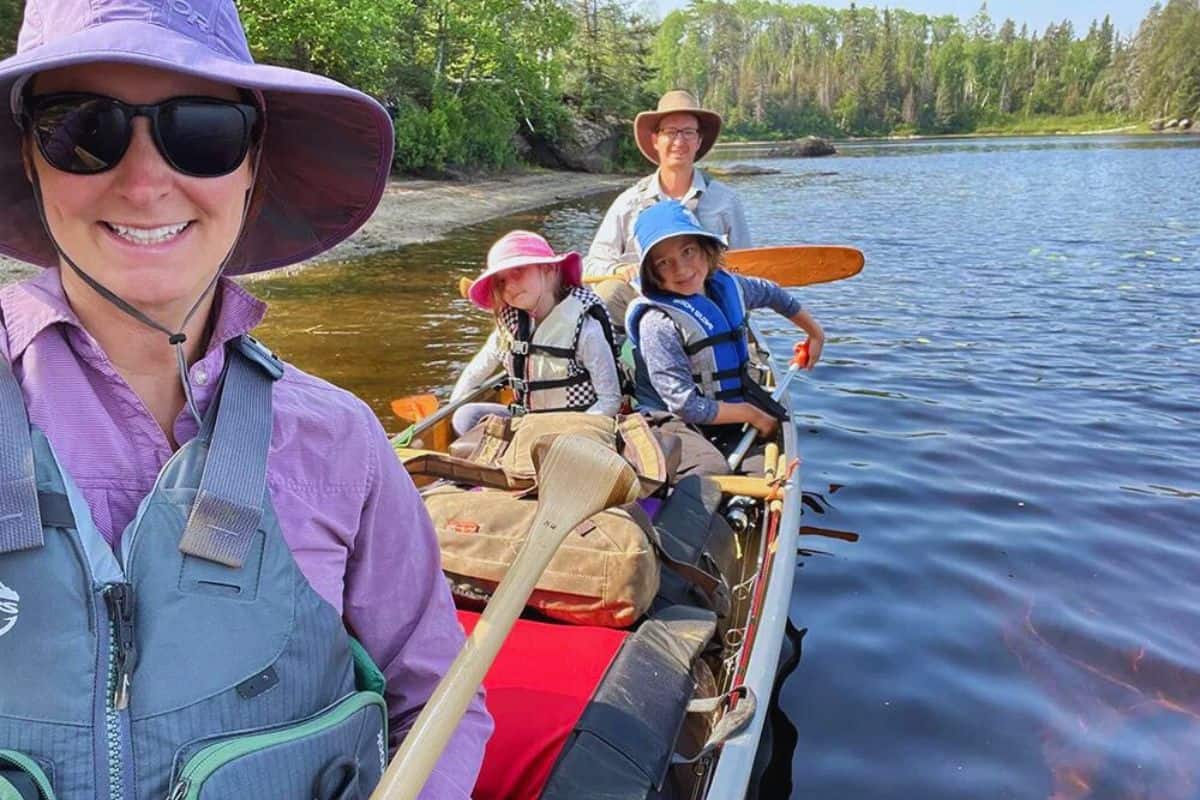
The Ultimate Guide to Canoe Camping with Kids
If you’ve ever dreamed of combining your love of canoeing with camping in the wilderness, you’re in for a treat. Today, Anthony Quill (of From Tent to Takeoff), a passionate outdoorsy Minnesota dad, is here sharing his insights and experiences canoe camping with kids. In this comprehensive guide, he’s included everything you need to know about canoe camping with kids, from where to go, what to pack, and tips for keeping the little ones entertained in the great outdoors. Join us as we navigate the waters of family-friendly canoe camping, creating lasting memories and fostering a love for nature in the hearts of your children. Let the adventure begin!
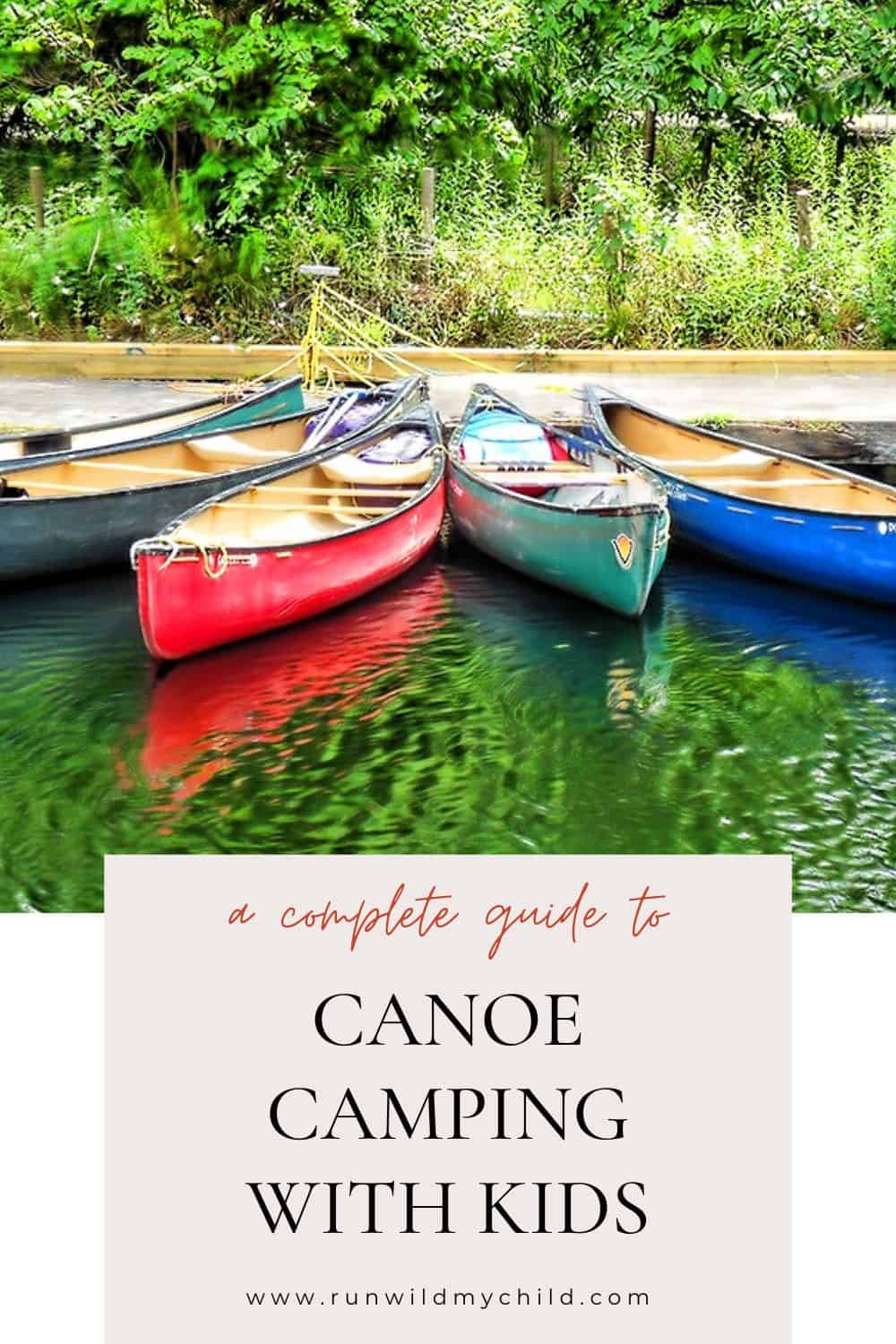
Canoe camping with kids
Canoe camping is a remarkable adventure that offers a unique blend of nature, exploration, and quality family time. Stepping away from the hustle and bustle of everyday life and immersing yourselves in the serene beauty of the great outdoors can create unforgettable memories and strengthen your family bond.
In this ultimate guide to canoe camping, we will delve into the benefits of time outdoors, the essentials of planning, packing, choosing the right destinations, and some lessons learned from almost four decades of canoe country experience. So, grab your paddles, gather your gear, and embark on an unforgettable journey into the world of canoe camping. The rewards and memories await you just beyond the shoreline.

What is canoe camping?
Benefits of canoe camping
Canoe camping allows families to disconnect from screens and distractions, replacing them with the soothing sounds of water, the rustle of leaves, and the chorus of birdsongs. It offers a chance to slow down, breathe fresh air, and appreciate the wonders of nature together.
One of the reasons why I think canoe camping with kids is so rewarding is the opportunity it provides for hands-on learning. As you paddle along calm waters, your children can observe different species of birds, identify various plants, and even spot unique wildlife like moose and deer. It’s a chance to ignite their curiosity, foster a deep appreciation for the environment, and cultivate a sense of stewardship for the natural world.
Beyond the educational aspects, canoe camping encourages quality family time. With limited distractions, you can engage in meaningful conversations, share stories around a crackling campfire, and laugh together while navigating, or getting lost, on your route. It’s an opportunity to create a shared experience that will be cherished for years to come.
Canoe camping also offers a sense of adventure and the thrill of exploration. Discover hidden coves, secluded beaches, and breathtaking landscapes that are only accessible by water. Paddling through serene lakes or gentle rivers allows you to explore nature at your own pace, stopping along the way to swim, fish, or simply bask in the tranquility of your surroundings.
Furthermore, the self-sufficiency required during a canoe camping trip can instill valuable life skills in young children. They can learn to set up camp, cook meals, and adapt to different situations, fostering independence, resilience, and problem-solving abilities.
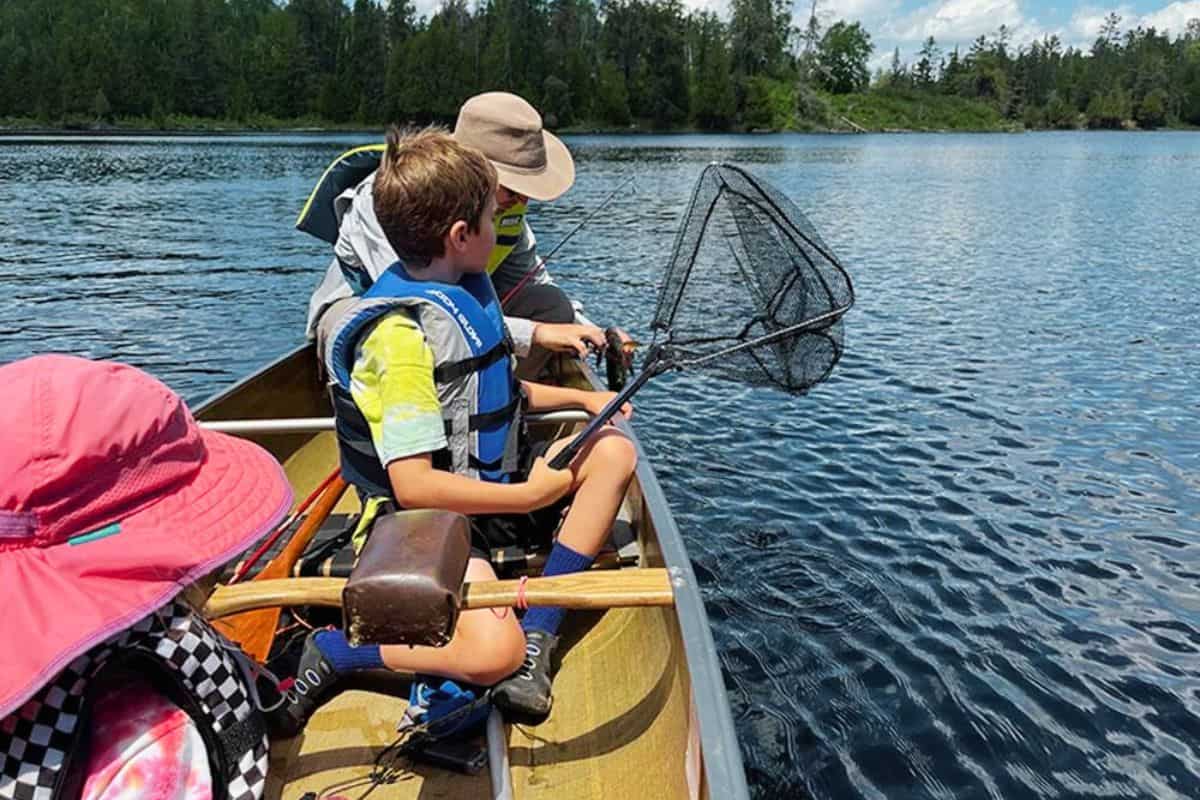
What to pack for canoe camping
Canoe camping requires careful planning and packing to ensure a comfortable and enjoyable experience. Usually, you can take more (and heavier) items than you can take on a backpacking trip (as you won’t be carrying your items), but less than you can pack on a traditional car camping trip (as everything needs to fit into the canoe (along with all the people in your family).
*Don’t forget to pack a little bit extra patience and flexibility, as unpredictability is part of the charm when embarking on canoe camping adventures with kids.
Here’s a comprehensive list of essential items to pack for your adventure:
Camping gear:
- Tent with rainfly and groundsheet
- Sleeping bags and sleeping pads
- Headlamps
- Knifes and portable camp saw
- Fishing poles and tackle
Clothing:
- Quick drying clothing (shorts, pants, t-shirt, long-sleeve shirt)
- Rain jackets, ponchos, or waterproof gear
- Sturdy hiking shoes or water sandals
- Swimsuits and quick-drying towels
- Extra wool socks and underwear
Food and cooking equipment:
- Plenty of meals and snacks (dehydrated backpacking meals work great)
- Cooking utensils, pot to boil water, and a cooking pan
- Backpacking stove
- Water filter and containers to store filtered water
- Eating utensils, plates, and cups
Safety equipment:
- First aid kit fit for your group size
- Insect repellent (lots) and sunscreen
- Life jackets that are comfortable to wear all day
- Whistle or signal mirror for emergencies
- Maps, compass, and Emergency Locator Beacor or GPS device
- Knife, saw, lighter, and waterproof matches
Personal items:
- Toiletries and biodegradable camp soap
- Prescription medications and basic over-the-counter remedies (i.e. kid and adult Tylenol)
- Personal identification and emergency contact information
- Cash or cards for emergencies
- Entertainment items for kids, such as books, toys, and games
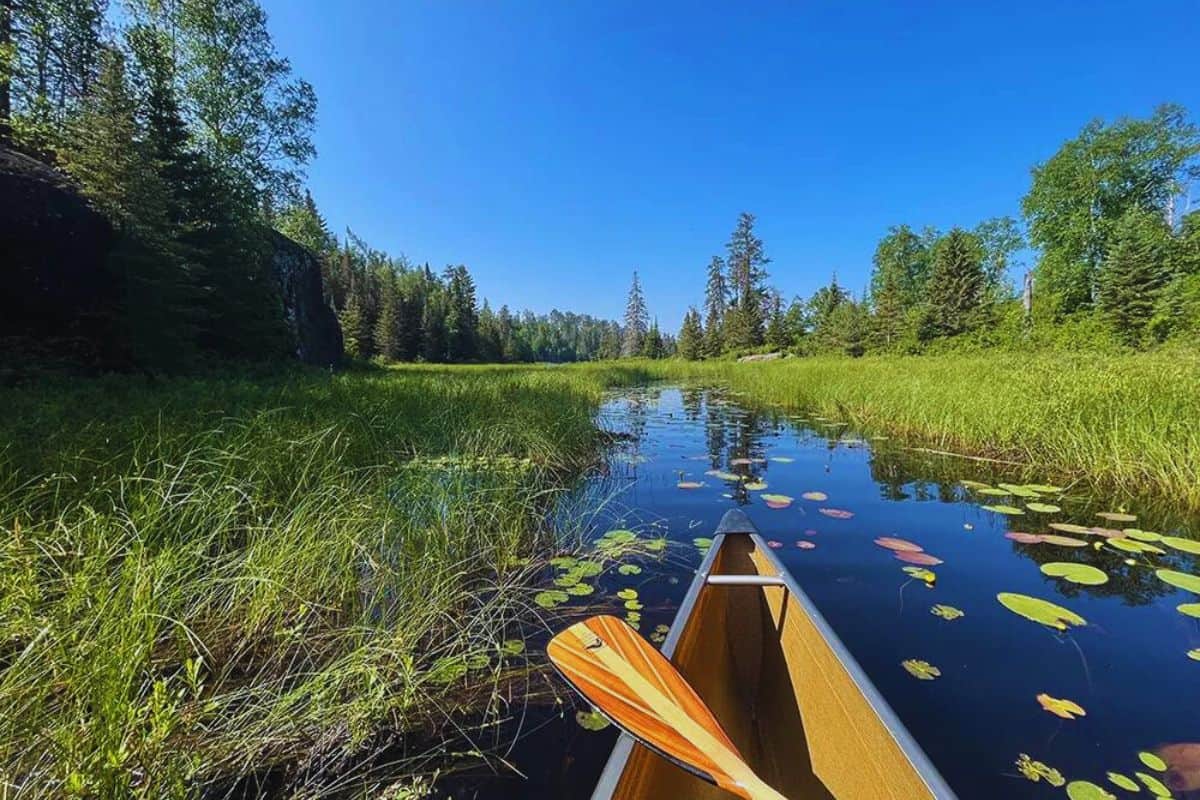
Packing tips
Remember to pack efficiently to keep the weight manageable, especially when portaging between lakes or rivers. Distribute the load evenly between canoes and ensure easy access to frequently used items. We prefer portage packs lined with a plastic bag that are custom-made to fit in a canoe. Traditional backpacking bags also work.
When packing the canoe, you want to make sure everything stays evenly distributed and dry. Wet/dry back can be a lifesaver in the event of a tip or rain. Before setting off at your entry point, make sure your gear is securely packed and waterproof; a soggy sleeping bag at the bottom of the canoe is an experience best avoided. Even with limited gear, prioritize much space for movement and comfort in your canoe, ensuring a relaxed and enjoyable experience for everyone on board.
If you are new to canoe camping, call an outfitter to help you with your first time. They can be a great resource even if you are not using their full guided services.
Want to pack like the pros? Then check out our exact packing list for our Boundary Waters Canoe Area Wilderness trips.
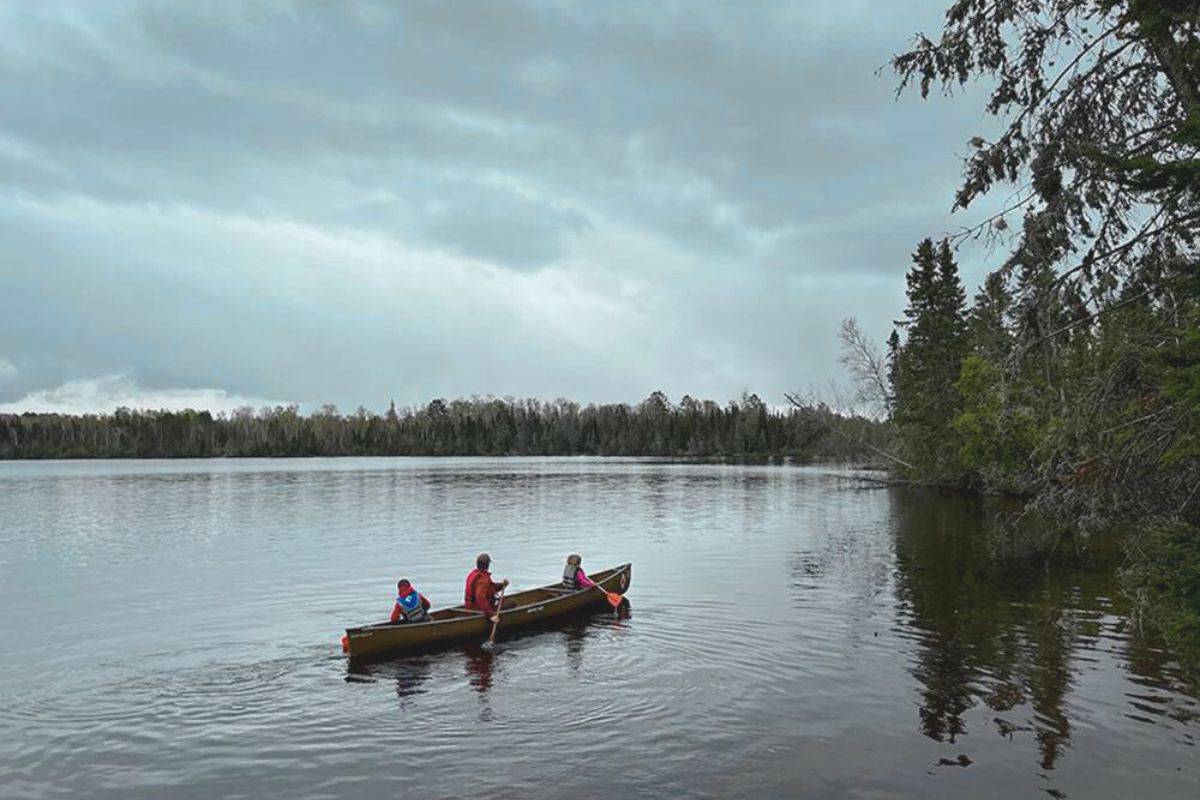
Where to go canoe camping with kids
Discovering the best places for family canoe camping involves seeking tranquil lakes with calm water, scenic landscapes, and ample opportunities for exploration. Choosing the right destination for your canoe camping adventure is crucial, especially when traveling as a family. When selecting a destination, consider factors such as accessibility, regulations, and the suitability of water conditions.
As a general rule of thumb, small lakes/rivers are much better if you are bringing kids than large ones. Check with local park authorities or experienced canoe camping organizations for updated information and permits. Opt for routes with a short portage if you’re venturing out with younger kids, making the journey more manageable and ensuring everyone arrives at the next waterway with smiles intact. Also, choosing routes with calm water can be helpful, especially when traveling with younger kids or novice paddlers.
Here are some family-friendly canoe camping destinations that offer breathtaking scenery and exciting activities:
Local waterways (best for beginners):
The options below are large and beautiful destinations (think bucket list worthy), but the best place to canoe camp is the one that’s accessible to you and gets you out on the water! The options listed below are amazing, but they may not be suitable for your first canoe camping trip with the family.
When you first start canoe camping, we recommend checking out your area’s local rivers and lakes. Here in Minnesota, we have a number of State Parks that offer canoe-in campsites that can give you a flavor of a big canoe camping trip without the commitment! Many rivers also allow for camping on banks and sandbars, which is a perfect way to start for your first trip.
Embarking on your first canoe trip? Start with short, manageable routes, gradually building confidence and expertise for more extended adventures. Ease into canoe camping with kids. Start small your first time and make each future trip slightly longer, harder, or both!
National(ish) Parks:
Algonquin Provincial Park, Ontario, Canada: Known for its stunning lakes and wildlife, Algonquin offers numerous canoe routes suitable for families, including shorter trips and designated campsites.
Boundary Waters Canoe Area Wilderness, Minnesota, USA (our favorite, and technically not a National Park): With its interconnected lakes and pristine wilderness, this area provides a serene environment for canoe camping and offers various entry points for different skill levels.
Lakeside camping:
Lake Powell, Arizona/Utah, USA: This picturesque reservoir offers beautiful sandy beaches and secluded coves for camping. Kids can enjoy swimming, fishing, and exploring the stunning red rock formations.
Lake District, England: With its vast network of lakes and stunning landscapes, the Lake District provides an ideal setting for canoe camping. Families can paddle on Windermere, Ullswater, or Coniston Llkes, surrounded by breathtaking scenery.
River adventures:
Allagash Wilderness Waterway, Maine, USA: This 92-mile-long waterway provides a wilderness experience with opportunities for wildlife sightings. It offers calm waters and numerous camping spots along the riverbanks. This offers a similar experience to the Boundary Waters Canoe Area Wilderness.
Dordogne River, France: The Dordogne River is perfect for family canoe camping, with its gentle currents and scenic countryside. Paddle through medieval towns, explore castles, and enjoy picnics along the riverbanks.
Buffalo National River, Arkansas: For a scenic, family-friendly canoe camping getaway, consider the serenity of Buffalo National River. The gentle currents and lush surroundings create an idyllic setting for outdoor bonding.
Coastal escapes:
Everglades National Park, Florida, USA: Discover the unique ecosystem of the Everglades by canoeing through mangrove tunnels and coastal waterways. Look out for alligators, manatees, and a variety of bird species. Here’s a great post on what to expect when exploring Everglades National Park with kids.
Stockholm Archipelago, Sweden: Explore the stunning archipelago with its thousands of islands, calm waters, and cozy camping spots. Enjoy the tranquility of the Swedish nature and picturesque fishing villages.
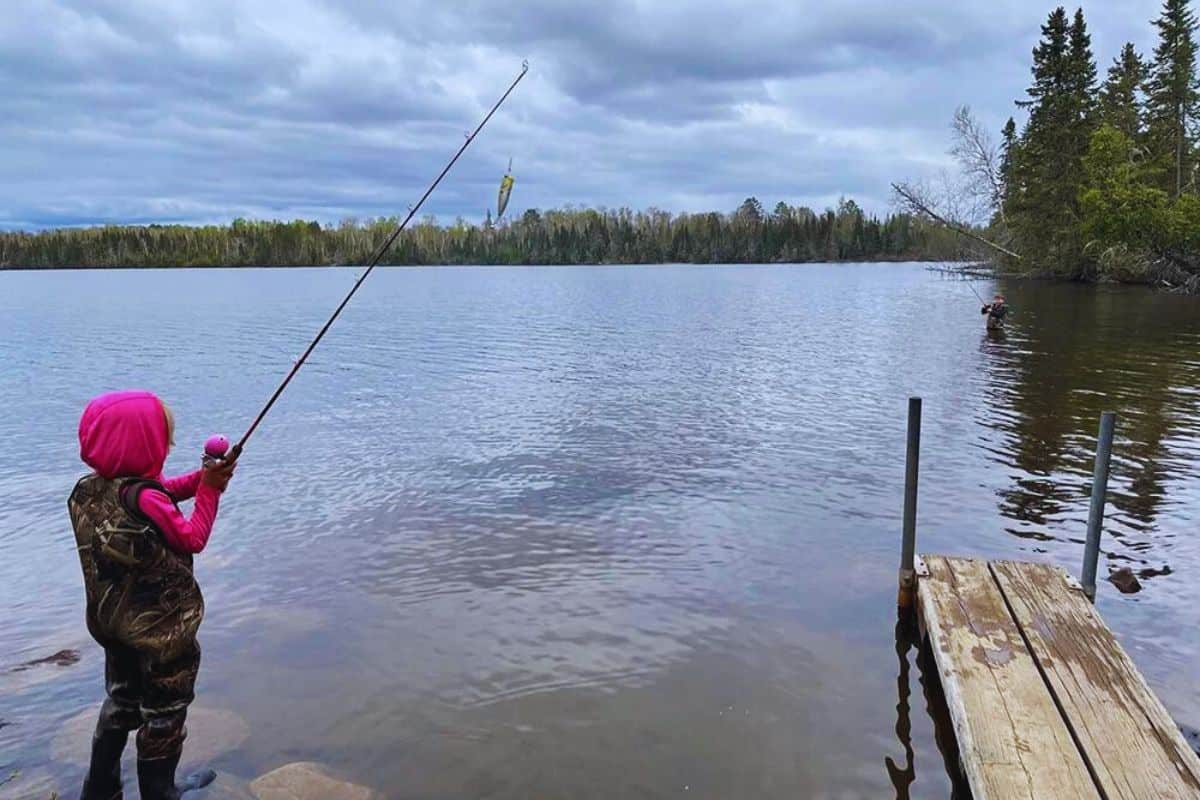
What to do when canoe camping
Canoe camping offers a range of exciting surprises and activities to keep kids engaged and entertained. Bringing along a selection of nature-themed games and activities is always a good idea to keep the little adventurers engaged and entertained in the canoe and during downtime at the campsite. Here are some ideas to make your adventure memorable:
Nature exploration:
Wildlife spotting: Encourage kids to observe and identify birds, animals, and plant species along the shores. Keep binoculars and a field guide handy for identification. We like to study up on key species ahead of time and then try to identify them in the field.
Nature scavenger hunt: Create a list of items found in the area you are visiting, such as different types of leaves, animal tracks, or specific rocks, and challenge the kids to find them during hikes or paddling breaks. Scavenger hunts are a great way to get little kids actively observing nature around them.
Fishing:
Teach kids basic fishing skills, such as casting and reeling, and let them experience the excitement of landing a keeper. Here’s some info on how to get started teaching kids to fly fish.
Campfire cooking:
Involve the kids in preparing meals over your campfire. They can help gather firewood, mix ingredients, and assemble simple recipes like foil packet meals or s’mores. Here’s a great post on getting kids involved in camp cooking.
Storytelling and stargazing:
Share stories and legends around the campfire can create a sense of awe. Additionally, stargazing during clear nights offers a chance to identify constellations and share stories about the cosmos. Unfortunately, we rarely do the latter, since it means our young kids would be staying up until 10PM with our late summer sunsets, but it’s a great idea for older kids. Here’s a great post on incorporating storytelling into your stargazing adventures.
Water activities:
Swimming and snorkeling: If the water conditions permit, let the kids cool off by swimming or snorkeling. Cliff jumping is also a great option if you are certain the landing zone is deep and clear of debris.
Canoeing and kayaking games: Organize friendly races, relays, or paddling challenges to keep the kids active and engaged while on the water. Here are some great ways to get kids active on the water.
Nature crafts:
Encourage creativity by collecting natural materials like rocks, shells, or driftwood to create crafts. Kids can make nature-inspired artwork, jewelry, or even build miniature shelters using sticks and leaves.
Our kids love charring a stick in the fire and then using it as a pencil to draw on pieces of birchbark. We bring them home and hang them in their room and they last for years!
In the great outdoors, even the simplest moments—like cooking over a campfire or stargazing from the comfort of your tent—can become the great things that shape cherished family traditions.
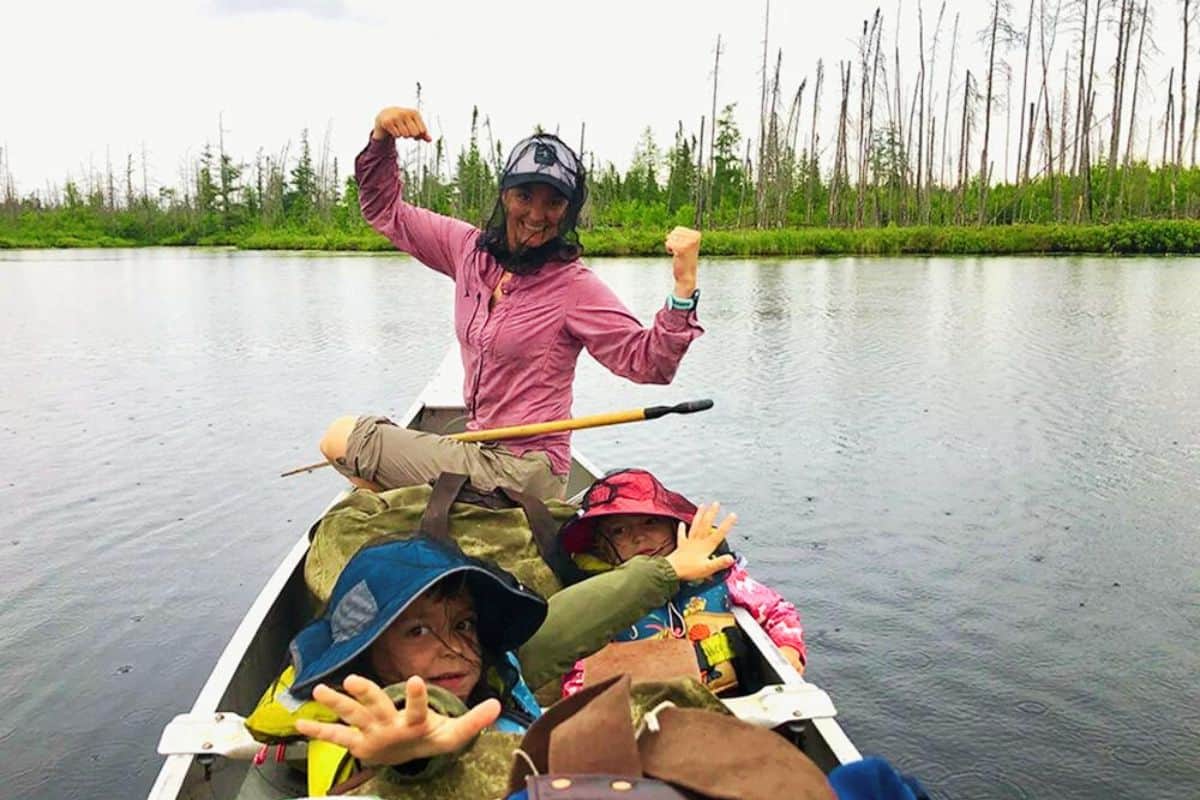
Canoe camping gear
The right gear is crucial for a successful and enjoyable canoe camping trip with kids. Here are some essential items to consider:
Canoe and paddles:
Choose a stable and family-friendly canoe with enough space for everyone and their gear. We use a Northstar Northwind 18 kevlar canoe, which has a third bench seat in the middle where both kids sit.
Select paddles suitable for each family member’s height and strength. We use adjustable paddles to accommodate our growing kids.
Life jackets and safety gear:
Ensure each family member has a properly fitting and Coast Guard-approved life jacket. Look for jackets specifically designed for children and make sure they are comfortable enough to be worn all day long. Here’s a full post on the best life jackets for kids.
Carry essential safety gear, such as a whistle, signal mirror, rope, GPS/Emergency Locator Beacon, etc. in your life jacket pockets or a dry bag.
Camping equipment:
Family-sized tent: Invest in a spacious tent that can comfortably accommodate all family members and has room for sleeping bags and gear. You don’t have to use an ultralight (backpacking) tent, but it will save you space and weight in your canoe. We use an REI Half-dome Trail Hut 4+ backpacking tent and love it.
Sleeping gear: You need a lightweight (we like hydrophobic down) sleeping bag that is warm enough for any weather you might encounter. We also use inflatable sleeping pads for comfort and warmth. Nemo, Sea 2 Summit, and Big Agnes all make great ultra-light sleeping pads.
Camp kitchen: Bring cooking utensils, pots, pans, and a portable stove for meal preparation. Less is more. We bring two bowls and often eat out of the freeze-dried meal bags. This means less weight and fewer dishes to clean!
Water containers and purification: In most cases, you will be purifying your own water on your canoe camping trip. We bring a couple of Nalgene water bottles, a gravity filter, and a 10L water bladder to hold excess purified water.
Lighting: Make sure you bring a couple of headlamps, lanterns, and/or flashlights.
Storage and organization:
Dry bags and waterproof containers: When canoe camping with kids, you want to be sure to keep clothes, food, and important items dry by using dry bags or waterproof containers. We line our canoe packs with heavy-duty garbage bags and bring personal dry bags for use during the day. We like the Sea 2 Summit dry bags that come in a variety of sizes.
Gear storage: Mesh bags and compression sacks are your friend! They are a great way to help keep your gear organized and help pack down big items (sleeping bags) so they fit better in your packs.
Clothing and personal items:
Choose quick-drying, moisture-wicking clothing suitable for local weather conditions. Include extra layers for cooler evenings and rain gear for wet conditions or bad weather.
Pack personal items like toiletries, medications, insect repellent, sunscreen, hats, and sunglasses to ensure comfort and protection from the elements.

What we’ve learned from canoe camping with kids
We’ve learned a lot from almost four decades of canoe country experience. Below are some practical tips and advice that we wish we’d known from the start.
Plan for rest days:
Depending on the length of your trip, consider incorporating rest days into your itinerary. This allows everyone to relax, explore the surroundings, and engage in activities at a leisurely pace. On long multi-day trips, we use a one-day on, one-day off schedule. This means we are changing campsites every other day.
Involve kids in trip planning:
Get the kids involved in the trip-planning process by allowing them to choose destinations, activities, or meals. This helps foster a sense of ownership and excitement, making them more engaged throughout the journey. It is harder for them to complain about what they are doing when it is their choice!
Optimize packing:
Evaluate your gear and assess if there are any unnecessary or duplicate items. Streamline your packing list to minimize the weight and maximize space, making portaging and setup easier. Less truly is more.
Prioritize comfort:
Invest in quality sleeping gear, such as thicker sleeping pads or inflatable mattresses, to promote quality sleep. While we personally do not use them, comfortable camp chairs and portable tables can also make a significant difference during meal times and relaxation.
Incorporate variety into activities:
Switch things up. Mix in different activities on different days. Balance physical exertion, such as paddling or hiking, with more relaxed activities like fishing, swimming, or nature observation. However, in our experience, the kids are never the ones needing more relaxed activities.
Embrace flexibility:
Allow for flexibility in your itinerary to accommodate unexpected weather changes or spontaneous discoveries. This flexibility can add excitement and reduce stress during the trip. Some of our best trips are the ones that we followed our plan the least.
Teach leave no trace principles:
Educate your kids about the importance of Leave No Trace principles, such as packing out trash, respecting wildlife and vegetation, and minimizing campsite impact. Instilling these values early on promotes responsible and sustainable outdoor practices.
Above all, remember that the most important thing during your canoe camping expedition with kids is to embrace the journey, fostering a sense of wonder and shared family memories. Remember, every trip is a learning experience, so don’t worry if the first one isn’t perfect!
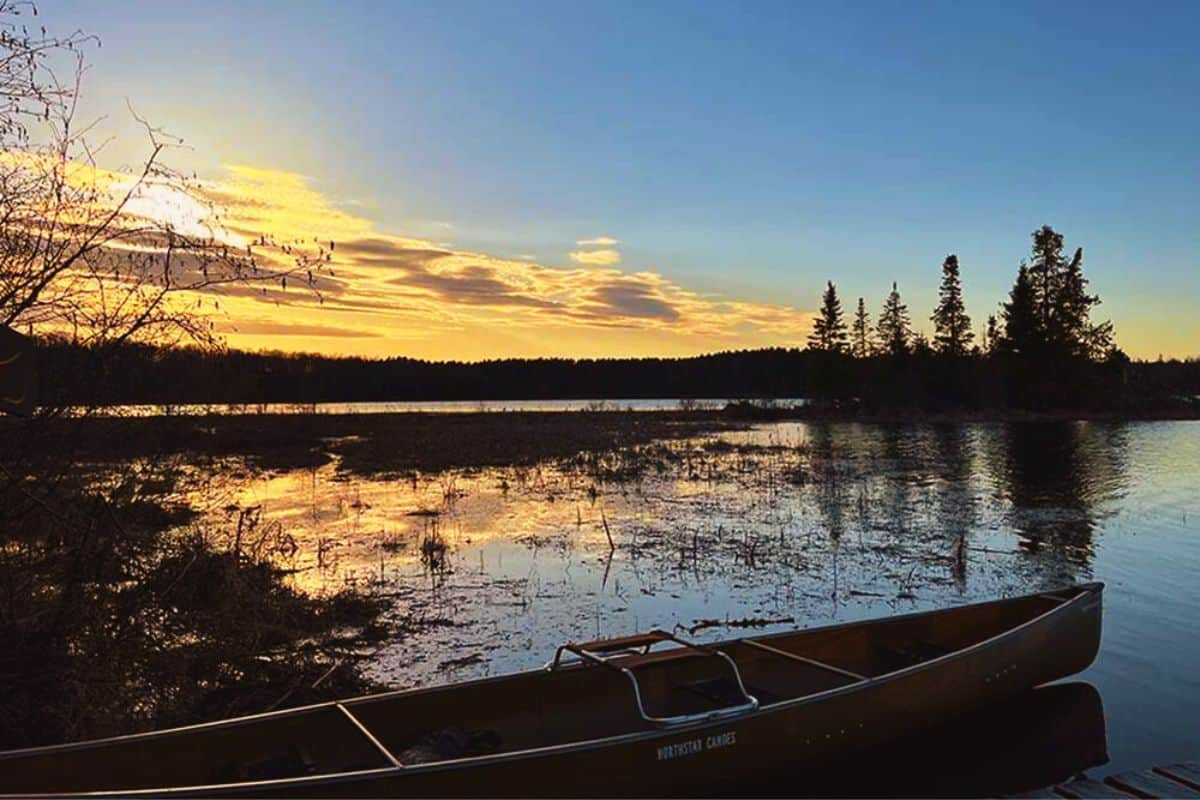
Canoe camping websites and resources
Thankfully, there are a ton of great resources for families looking to try canoe camping and want to learn the ropes. Here are some helpful websites and resources:
From Tent to Takeoff: (www.fromtenttotakeoff.com) This is our family blog where we document our trips and provide advice on how to make the most out of your family adventures
Paddling.com: Paddling.com offers a wealth of information on canoeing and kayaking, including trip reports, gear reviews, and destination guides. Their forums and community provide opportunities to connect with fellow paddlers and share experiences.
National Park Service (nps.gov): Visit the website of the National Park Service to explore canoeing opportunities in various national parks. Check out park-specific information, regulations, and camping options for a safe and enjoyable experience.
American Canoe Association (aca-paddler.org): The American Canoe Association is a valuable resource for paddlers of all skill levels. Their website provides safety guidelines, instructional videos, and a directory of certified instructors for those looking to enhance their canoeing skills.
Canoe Camping Club (canoecamping.club): The Canoe Camping Club is a community of canoe camping enthusiasts. Their website offers trip reports, gear recommendations, and a forum to connect with other families who share a passion for canoe camping.
Local tourism board websites: Check the official websites of local tourism boards for your desired canoe camping destinations. They often provide information on campsites, canoe rental services, maps, and local attractions.
Outdoor retailer websites: Visit outdoor retailer websites like REI (rei.com) or MEC (mec.ca) for gear recommendations, buyer’s guides, and informative articles on outdoor activities, including canoe camping.
Canoe camping with kids
Canoe camping with kids offers a remarkable opportunity to connect with nature, create lasting memories, and foster a love for outdoor adventures. By following the tips and insights shared in this ultimate guide, you can ensure a successful and enjoyable experience for the entire family.
Safe travels and happy canoe camping!
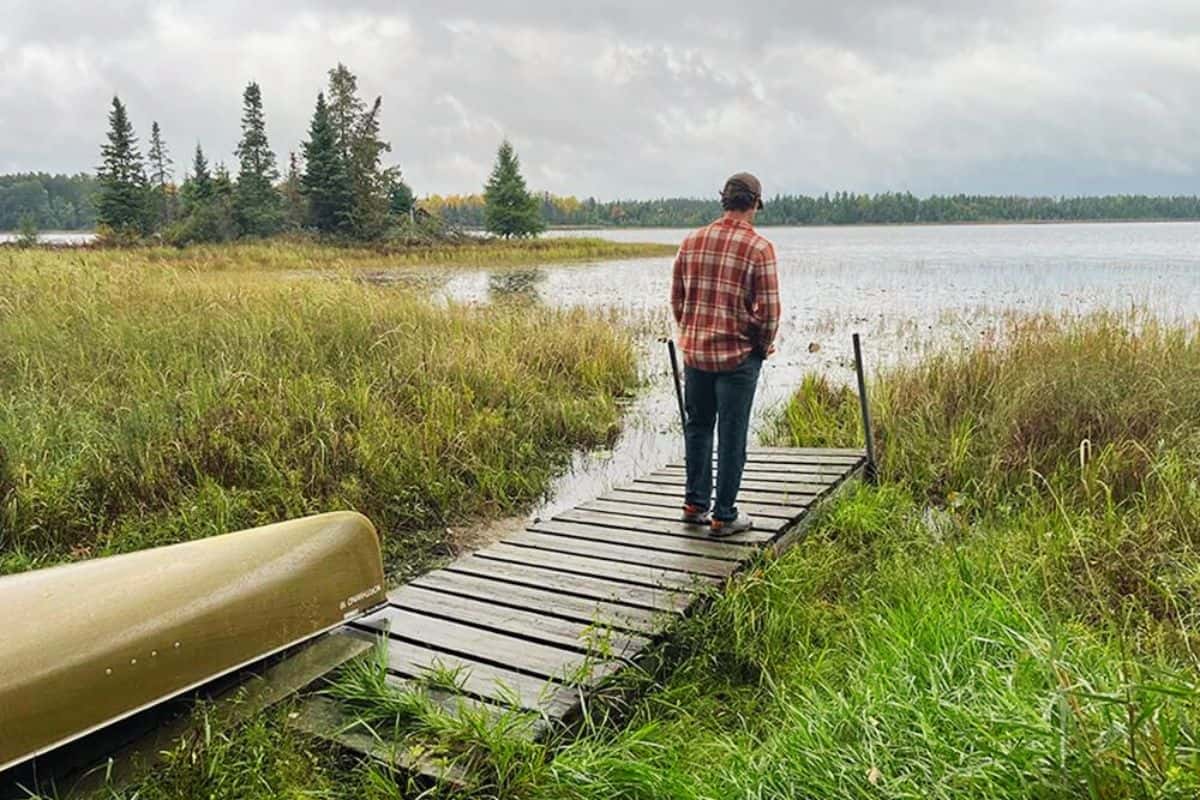
About the author
Anthony Quill is a Minnesota dad and blogger who loves experiencing epic adventures with his wife and two kids. He is Twin Cities-based but globally bound, traveling with his family everywhere from Minnesota’s North Shore to Morocco, Spain, and Italy. No matter the distance, he always returns to his roots on the North Shore, and in particular the Boundary Waters Canoe Area Wilderness. Learn more about his family’s adventures on their blog at From Tent To Takeoff, on Instagram at @fromtenttotakeoff, or on Facebook at @fromtenttotakeoff.

Leave a Reply